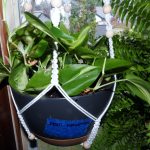This post may contain affiliate links. If you buy something from one of our links we may earn a commission. Thanks
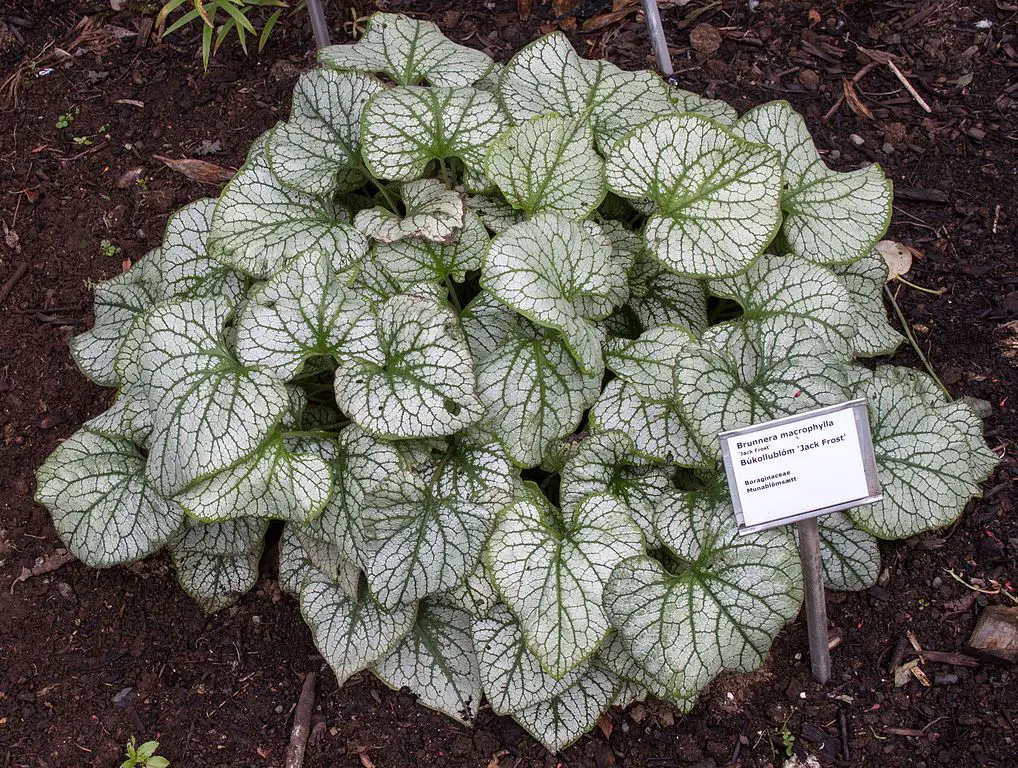
If you are looking for a spectacular easy-to-grow shade plant you will want to learn more about Siberian Bugloss Care aka Brunnera macrophylla.
Siberian Bugloss Care aka Brunnera macrophylla
Let’s learn more about Siberian Bugloss Care. This is a hardy easy-to-grow shade plant with pretty blue flowers and striking heart-shaped leaves variegated with white or silver. It is hardy in zones 3-8 or -35 °F.
It’s the perfect plant for Northern gardens as it likes it on the cool side and will struggle in hot humid Southern gardens.
I honestly don’t know why it isn’t more popular because it beats Hostas hands down but read on and you will soon want to plant it for yourself.
Siberian Bugloss Key Takeaways:
- Light Requirements: Siberian Bugloss thrives best in partially shaded to shady locations. It can tolerate some sun if the soil is moist, but avoid placing it in direct midday sun.
- Soil Preferences: This perennial prefers humus-rich, loamy, well-drained, and moist soil. It’s important for the soil to be nutrient-rich to support its growth.
- Watering: Regular watering is essential, especially during dry spells. The plant prefers consistent moisture. Water directly onto the root area and avoid getting the leaves wet.
- Fertilization: Enrich the soil with compost before planting. You may also fertilize from spring until the end of the flowering period using compost, slow-release fertilizer, or liquid fertilizer for perennials.
- Division: Siberian Bugloss can be divided in early spring before the flower buds form. This helps to manage its size and spread.
- Propagation: Propagation can be done best by division. Seeds usually do not grow true to type.
- Pruning: Cut back the plant after flowering to prevent seed development but leave the tops for winter protection and remove them in the spring.
- Pest and Disease Resistance: The plant is largely resistant to pests and diseases due to its rough leaves. However, avoid overwatering or leaving the leaves wet in direct sunlight.
- Winter Hardiness: Siberian Bugloss is very hardy, withstanding temperatures down to -37°C (-35°F). No special winter protection is needed.
- Garden Use: Ideal for shady perennial beds, as ground cover under trees and shrubs, and in combination with hostas, ferns, primroses, and daffodils.
- Attractive foliage makes it suitable for growing in pots as well. But if you want to keep it as a houseplant it does need a winter dormancy period.
- Remember to give the plant time to establish itself in your garden, as it may take a couple of years for a full, lush growth to develop.
- This is Siberian Bugloss Care in a nutshell but read on because we will cover Brunnela care in more detail further down.
This is Siberian Bugloss Care in a nutshell but please read on because we will cover Brunnela care in more detail.
Overwintered Brunnera macrophylla Video Update
Many Different Names: What is Siberian Bugloss?
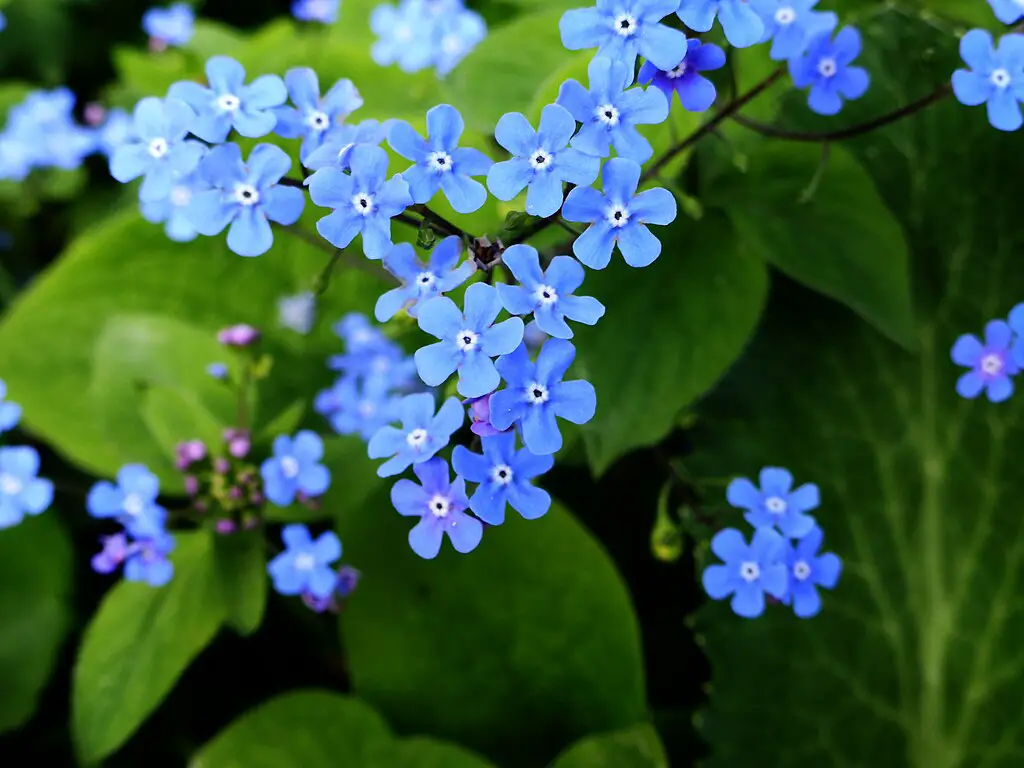
Besides its scientific name (Brunnera macrophylla), Siberian Bugloss is also known as Great Forget-me-not, False Forget-me-not, Largeleaf Brunnera, and Heartleaf Brunnera.
Some of these names highlight the Brunnera flower resemblance to the forget-me-not and its distinctive foliage.
Brunnera Jack Frost vs Queen of Hearts
My plants just arrived and here is a video:
So say hello to the Siberian Bugloss (Brunnera macrophylla), a real treasure in the perennial world that loves the shade.
This plant is a big hit with gardeners looking to brighten up those shady corners. With its sky-blue blooms and heart-shaped leaves, it’s more than just a plant – it’s a showstopper that adds a burst of life and beauty to any garden.
In this guide, we’re going to dive into all the tips and tricks for keeping this gorgeous perennial thriving in your garden.
1: Getting to Know Your Siberian Bugloss
What is Siberian Bugloss?
Siberian Bugloss, or Brunnera macrophylla, is a perennial plant belonging to the borage family. Originating from the forests of Eastern Europe and Northwest Asia, this plant is known for its ability to thrive in shady environments.
Brunnera is a genus of flowering plants in the family Boraginaceae. They are rhizomatous perennials, native to the woodlands of Eastern Europe and North West Asia. They have hairy leaves and sprays of blue flowers in spring. Numerous cultivars are available, which are valued as groundcover in dappled shade. Some possess variegated foliage. The best known species is Brunnera macrophylla, known as Siberian bugloss. https://en.wikipedia.org/wiki/Brunnera
Characteristics:
This perennial grows compactly and bushily, reaching heights of 30 to 50 centimeters (12 to 20 inches).
Its leaves are heart-shaped, softly hairy, and medium to dark green, while from April to June, it boasts delicate, panicle-shaped, bright blue flowers.
2: Ideal Growing Conditions
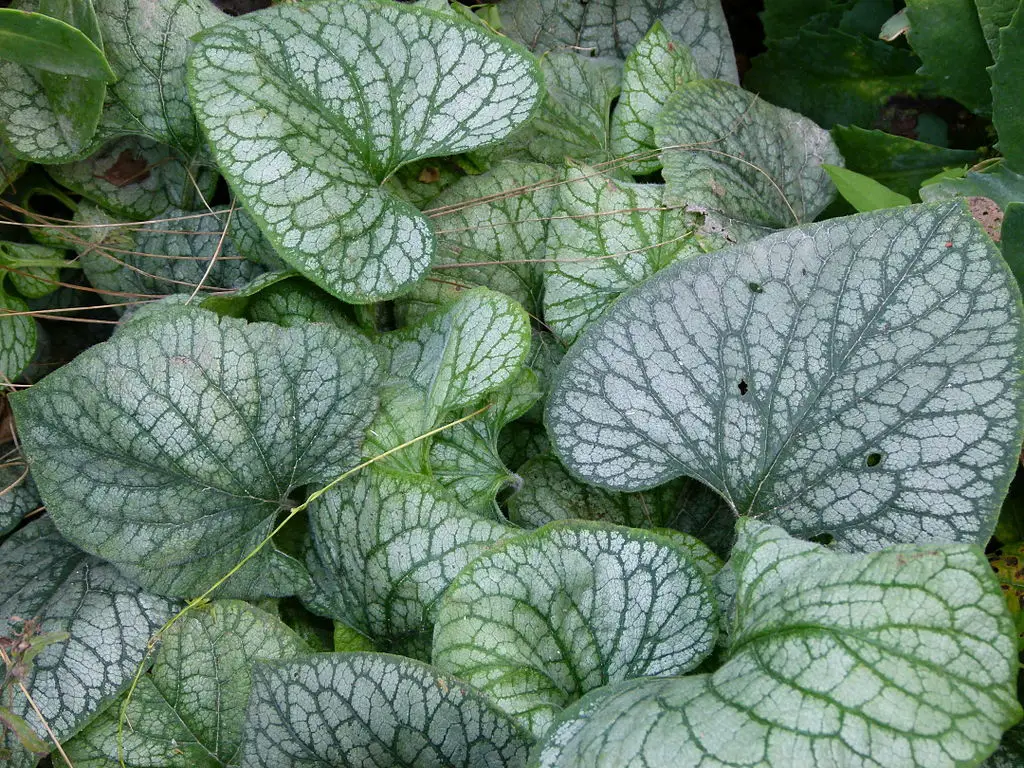
Welcome to the world of Siberian Bugloss and finding its happy place!
Just like us, every plant has its preferred hangout spot, and for this beauty, it’s all about the right light, soil, and climate.
Let’s dive into what makes this plant tick and how you can create the perfect spot for it to thrive.
Light Requirements:
Got a shady spot in your garden? Perfect! Siberian Bugloss loves hanging out in partial shade or even full shade.
It’s like a little ray of sunshine that doesn’t need much sunshine at all. So, don’t worry about those spots where the sun doesn’t quite reach – this plant has got you covered.
Soil Preferences:
Siberian Bugloss isn’t too picky, but it does enjoy good, rich soil. Think humus-rich, loamy, and well-drained, but still moist.
It’s all about recreating that cozy, forest-floor vibe. Give it that, and this plant will be as happy as a clam.
Climate and Hardiness Zones:
This plant is one tough cookie! It’s hardy in USDA Zones 3 through 8, so it can handle a variety of climates.
Whether you’re dealing with chilly winters or mild ones, Siberian Bugloss can take it in stride. Just plant it, and watch it do its thing!
3: Planting Siberian Bugloss
Ready to get your hands dirty? Planting Siberian Bugloss is a breeze, and with just a little know-how, you’ll have these beauties thriving in your garden.
Let’s walk through the best time to plant, how to space them out, and some handy tips to ensure your Bugloss feels right at home.
Best Time to Plant:
Spring is the prime time to plant Siberian Bugloss. This gives the roots a chance to establish themselves before winter sets in.
So, as soon as the frost says goodbye, get your Bugloss in the ground for a season full of growth.
Spacing:
When planting Siberian Bugloss, it’s best to space them about 12 to 18 inches apart. This allows each plant enough room to grow and spread, ensuring they don’t crowd each other out.
Plus, it helps create that lush, full look we’re all aiming for in our gardens.
Planting Tips:
- Soil Prep: Start with well-draining, humus-rich soil. If your soil is a bit on the heavy side, mix in some compost to lighten it up.
- Positioning: Plant your Bugloss in a spot that gets partial to full shade. They’re not sunbathers, so keep them cool and comfy.
- Watering: After planting, give them a good soak to help settle the soil around the roots. Keep the soil consistently moist, especially during dry spells.
With these tips in mind, you’re all set to add some Siberian Bugloss charm to your garden. Happy planting!
4: Essential Care Practices
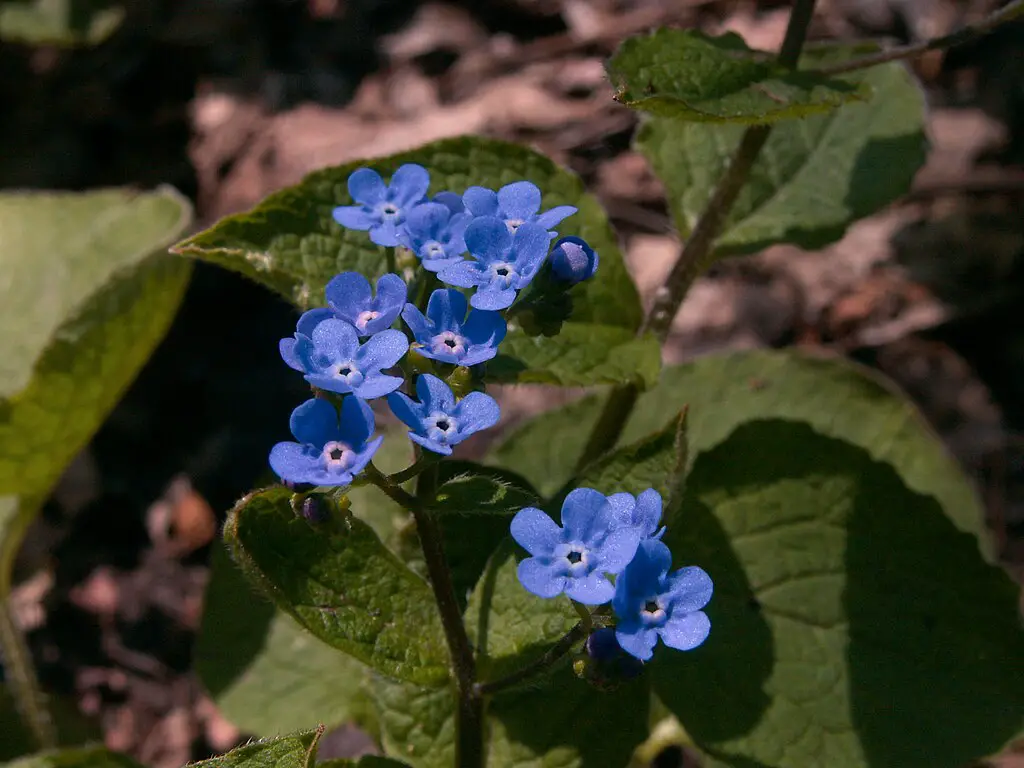
Keeping your Siberian Bugloss happy and healthy is a cinch with a few simple care practices.
Consistent moisture, a little bit of food, and an occasional dividing will keep your plants looking their best.
Let’s dive into the nitty-gritty of watering, fertilizing, and dividing these lovely perennials.
Watering:
Siberian Bugloss likes its soil like a well-made sponge cake – moist, but not soggy. During dry spells, give them a drink to keep the soil consistently moist.
And remember, it’s all about the roots, so aim your watering can at the base of the plant, not the leaves.
Fertilization:
Think of fertilizer as a little pick-me-up for your plants. In early spring, treat your Siberian Bugloss to some compost or a balanced slow-release fertilizer.
This will give them the nutrients they need to kick off the growing season with a bang.
Dividing:
Every few years, your Siberian Bugloss might start feeling a bit cramped. That’s when you know it’s time for a division.
In early spring, gently lift the plant, divide it into smaller sections, and replant them with some room to breathe.
Not only does this give them more space, but it’s also a great way to multiply your plant collection. Win-win!
5: Propagation Techniques
Siberian Bugloss is a generous plant, and there are a couple of ways to create more of these beauties for your garden or to share with friends.
Let’s explore how to propagate them through division and sowing seeds.
Propagation by Division:
Dividing your Siberian Bugloss is like giving it a fresh start, and it’s best done in early spring. Here’s a quick guide:
- Prepare: Choose a cool, cloudy day to keep your plants happy during the process.
- Dig: Gently dig around the base of the plant, being careful not to damage the roots.
- Lift: Carefully lift the plant out of the ground.
- Divide: Using a sharp knife or spade, divide the plant into smaller sections. Each section should have a good amount of roots and a few shoots.
- Replant: Plant your new divisions in their new spots, spacing them about 12 to 18 inches apart. Water them well to help them settle in.
Propagation by Sowing:
While you can grow Siberian Bugloss seeds, keep in mind that seedlings might not be true to the parent plant.
Some gardeners remove volunteer Brunnera seedlings and rely solely on division. But if you’re up for a little surprise, here’s how to do it:
- Collect Seeds: In late spring or early summer, collect seeds from the spent flowers of your Siberian Bugloss.
- Sow: Sow the seeds in a tray filled with a well-draining seed starting mix. Cover them lightly with soil.
- Moisture: Keep the soil moist but not waterlogged. A light misting works well.
- Germination: Place the tray in a bright spot, but out of direct sunlight. Seeds should germinate in about two to four weeks.
- Transplant: Once the seedlings have a couple of true leaves, you can transplant them into individual pots or directly into your garden.
Remember, when it comes to propagation, patience is key. Whether you’re dividing or sowing seeds, give your plants time to grow and establish themselves. Before you know it, you’ll have a garden full of Siberian Bugloss to enjoy!
6: Pruning and Maintenance
Keeping your Siberian Bugloss looking its best is all about a little TLC and knowing when to give it a trim.
Let’s talk about Brunnera plant care and how to keep your plants pruned and maintained, so they stay healthy and gorgeous all year round.
Pruning Schedule:
- After Flowering: Once the blooming season is over, usually around late spring to early summer, you can give your plants a light trim. This helps to remove any spent flowers and encourages a tidier appearance.
- In Autumn: As the growing season winds down, you can cut back the foliage to tidy up your garden. However, some gardeners prefer to leave the leaves in place over the winter to act as a natural mulch.
- In Spring: As new growth starts to appear, that’s your cue to remove any old, dead foliage from the previous year. This helps to make way for fresh, new leaves and flowers.
Maintenance Tips:
- Mulching: Applying a layer of organic mulch around your Siberian Bugloss can help retain soil moisture, regulate soil temperature, and reduce weed growth.
- Watering: Keep the soil consistently moist, especially during dry periods. Aim to water at the base of the plant to avoid wetting the leaves.
- Disease and Pest Monitoring: Keep an eye out for any signs of disease or pests. Healthy plants are less susceptible to issues, but it’s always good to catch any problems early.
- Winter Protection: The name Siberian Bugloss gives you a clue that this plant is plenty cold hardy. In colder regions, the natural leaf mulch can provide some extra insulation over the winter. Just be sure to remove it in the spring to allow new growth to come through.
By following these simple pruning and maintenance tips, you’ll help ensure your Siberian Bugloss continues to thrive and bring beauty to your garden year after year.
7: Disease and Pest Management
Siberian Bugloss is a pretty tough plant, but like all garden residents, it can encounter a few bumps along the way.
Let’s talk about how to keep pests and diseases at bay, so your plants stay happy and healthy.
Common Pests:
One of the great things about Siberian Bugloss is its resistance to many common garden pests. However, it’s not entirely immune. Here are a couple of critters to watch out for:
- Snails and Slugs: These slimy visitors can be attracted to the moist conditions Siberian Bugloss enjoys. To deter them, try using organic slug pellets or setting up beer traps.
- Caterpillars: Occasionally, caterpillars might decide to munch on your Bugloss. If you spot any, you can pick them off by hand or use an organic insecticide if the infestation is severe.
Disease Prevention:
While Siberian Bugloss is generally disease-resistant, it’s still important to practice good gardening hygiene to prevent any issues:
- Watering: Avoid overhead watering, which can leave the leaves wet and more susceptible to fungal diseases. Water at the base of the plant instead.
- Air Circulation: Make sure your plants have enough space between them for air to circulate freely. This helps to reduce the risk of fungal diseases.
- Cleanliness: Remove any dead or diseased foliage from around the plants to prevent the spread of disease.
- Soil Health: Keep your soil healthy with regular additions of organic matter. Healthy soil leads to healthy plants!
By keeping an eye out for pests and practicing good disease prevention, you can help your Siberian Bugloss stay strong and vibrant.
8: Siberian Bugloss Care in Winter
Siberian Bugloss is like the cool kid on the block when it comes to handling chilly weather.
But even the toughest plants appreciate a little extra TLC when winter rolls around. Let’s dive into its winter hardiness and some tips to keep it cozy during the colder months.
Winter Hardiness:
Good news for cold-climate gardeners – Siberian Bugloss is a winter warrior! It’s hardy down to USDA Zone 3, which means it can withstand temperatures as low as -40°F (-40°C).
So, if you’re in a region that gets a good dose of winter chill, this plant has got your back.
Winter Care Tips:
While Siberian Bugloss is pretty hardy, here are a few tips to give it some extra protection in colder climates:
- Leave the Leaves: As tempting as it might be to tidy up in autumn, leaving the foliage in place can provide a natural mulch, offering insulation against the cold.
- Mulch: Adding a layer of organic mulch, like bark or straw, can help protect the roots from extreme temperatures.
- Avoid Wet Feet: Make sure your Bugloss isn’t sitting in soggy soil over winter, which can lead to root rot. Good drainage is key.
- Spring Cleanup: Once the threat of frost has passed in spring, that’s the time to remove any old foliage and mulch to make way for new growth.
With these winter care tips, your Siberian Bugloss should emerge from the cold months ready to burst into life come spring.
9: Designing with Siberian Bugloss
Siberian Bugloss isn’t just a pretty face; it’s a versatile player in the garden design game.
Whether you’re aiming for a woodland vibe or a cottage garden charm, this plant can fit right in.
Let’s explore some creative ways to use Siberian Bugloss in your garden, along with some companion plants and varieties to consider.
Garden Uses:
- Ground Cover: Its lush foliage makes it an excellent ground cover for shady spots.
- Border Planting: Use Siberian Bugloss to create a beautiful, low-maintenance border along walkways or garden beds.
- Woodland Gardens: It’s right at home in a woodland garden, nestled among trees and other shade-loving plants.
- Containers: Smaller varieties can add a pop of color to shady patio containers or window boxes.
- Underplanting: Plant it under taller shrubs or trees to add interest to the lower levels of your garden.
Companion Plants:
Siberian Bugloss plays well with others! Here are some plants that make great companions:
- Ferns: The delicate fronds of ferns complement the heart-shaped leaves of Siberian Bugloss.
- Hostas: Pairing Hostas with Siberian Bugloss creates a stunning contrast in leaf textures and colors.
- Astilbes: The feathery blooms of Astilbes add a soft, airy touch to the bold foliage of Bugloss.
- Hellebores: Early-blooming Hellebores can provide a beautiful backdrop to the blue flowers of Siberian Bugloss.
If you have a shady spot consider planting Hostas, Ferns, Bleeding Hearts and Astilbe. Here is an article on Hosta care.
10: Brunnera Varieties
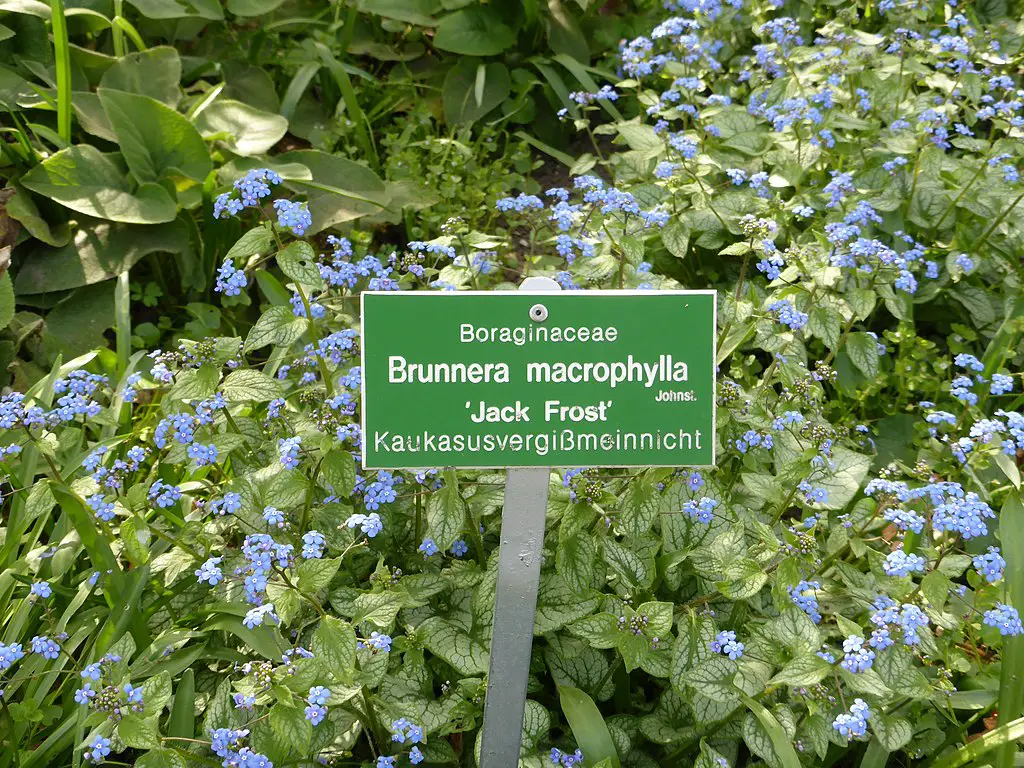
Here are some of my preferred varieties of Brunnera:
‘Jack Frost’:
This popular variety is known for its large, heart-shaped silver leaves edged and veined with green. It produces clouds of tiny, pale blue flowers in spring.
‘Queen of Hearts’:
This variety stands out with its heart-shaped leaves that have a silver overlay and a narrow band of dark green veining. It blooms with baby blue, forget-me-not-type blossoms and is known to attract bees while being deer-resistant.
‘Alexander’s Great Brunnera’:
Similar to ‘Jack Frost’ but larger, this variety forms a large mound of heart-shaped, heavily silvered leaves with contrasting green veins and edges. It produces attractive sprays of tiny, sky blue flowers in spring.
Each of these varieties brings its own unique charm to the garden with its stunning foliage and delicate blooms.
Brunnera Care FAQs
Brunnera, also known as Siberian Bugloss, is a charming perennial that adds a splash of color and texture to shady spots in the garden. Let’s dive into some frequently asked questions to help you get to know this plant better!
Q. Is Brunnera invasive?
A. Brunnera is not known for rapid spreading. It grows slowly, especially when first planted, but once established, it will continue to grow steadily. It’s an ideal choice for gardeners looking for a low-maintenance plant.
Q. Does Brunnera bloom all summer?
A. Brunnera’s vivid blue flowers bloom in mid to late spring for up to 10 weeks. While it doesn’t bloom all summer, its attractive foliage provides interest throughout the growing season.
Q. Does Brunnera like sun or shade?
A. Brunnera prefers partial to full shade. Too much direct sun can cause leaf scorch, so it’s best to plant it in a spot protected from hot afternoon sun.
Q. How far apart do you plant Brunnera?
A. Space Brunnera plants 18 to 30 inches apart, depending on the variety. This allows enough room for them to grow and spread.
Q. Should you divide Brunnera?
A. Yes, dividing Brunnera every few years can help control its spread and rejuvenate the plant. It’s best to do this in early spring or autumn.
Q. Should Brunnera be cut back in fall?
A. You can remove dried and brown foliage caused by too much sun or drought. But cutting back the foliage is not strictly necessary in the fall.
Q. What goes well with Brunnera?
A. Brunnera pairs well with other shade-loving plants like ferns, hostas, and hellebores. Its blue flowers and textured foliage complement a variety of garden styles.
Q. Can Brunnera tolerate afternoon sun?
A. Brunnera can tolerate some sun, especially if the soil is kept moist. However, it’s best to avoid planting it in areas with hot afternoon sun to prevent leaf scorch.
Q. Does Siberian Bugloss like sun or shade?
A. Siberian Bugloss, another name for Brunnera, prefers shade. It thrives in partial to full shade and should be protected from direct afternoon sun.
Q. Is Siberian Bugloss invasive?
A. Siberian Bugloss is not considered invasive. It’s a well-behaved garden plant that adds beauty to shady areas without taking over.
Q. How do you take care of a Brunnera plant?
A. To care for Brunnera, plant it in moist, well-drained soil in a shaded area. Water regularly to keep the soil moist but not waterlogged. Fertilize sparingly, if at all, and remove any damaged leaves to keep the plant looking its best.
Happy gardening, and enjoy the beauty of Brunnera in your shade garden!
Read more: The Beginner’s Guide to Starting a Backyard Urban Garden
Siberian Bugloss Care Conclusion
As we wrap up our guide on Siberian Bugloss care, let’s quickly revisit the essentials.
This beautiful perennial thrives in partial shade with moist, well-draining soil. Regular watering, occasional fertilization, and proper spacing will ensure its success in your garden.
Its resistance to pests and hardiness in various climates make it a low-maintenance choice for adding vibrant color and texture to shady areas.
Key Points Recap:
- Ideal for partial shade
- Requires moist, well-draining soil
- Benefits from regular watering and occasional fertilization
- Pest-resistant and hardy in USDA Zones 3-8
A Call to Gardeners:
Why not add Siberian Bugloss to your garden? Its captivating blue flowers and lush foliage are sure to enhance the beauty of any shady nook.
Embrace this shade-tolerant gem and watch your garden transform into a serene, colorful retreat.
Brunnera Care Resources
For those looking to dive deeper into the world of Brunnera and its care, here are some helpful sources to explore:
- Wisconsin Horticulture – University of Wisconsin Extension: Provides an in-depth look at ‘Jack Frost’ Brunnera, including its care, characteristics, and uses in the garden. Read more
- North Carolina Extension Gardener Plant Toolbox: Offers detailed information on Brunnera macrophylla, including its preferred growing conditions, landscape uses, and common varieties like ‘Jack Frost’, ‘Alexander’s Great’, and ‘Alchemy Silver’. Read more
- University of Maine Cooperative Extension: Discusses the possibility of growing Brunnera indoors in planters, providing insights into its dormancy requirements and care. Read more
These sources offer a wealth of information to help you successfully grow and enjoy Brunnera in your garden.
Visit my Amazon Influencer Page for videos and gardening products Grow Your Own Garden





